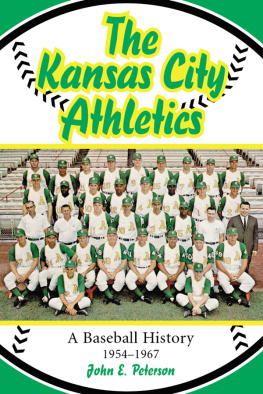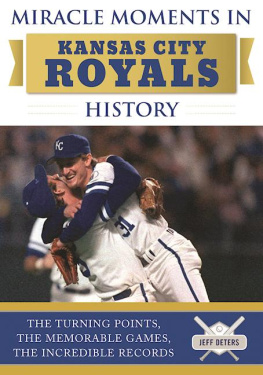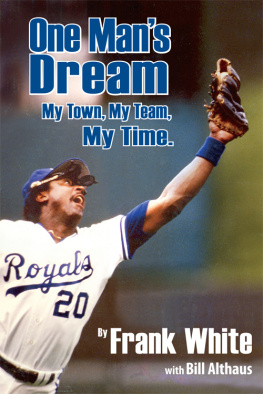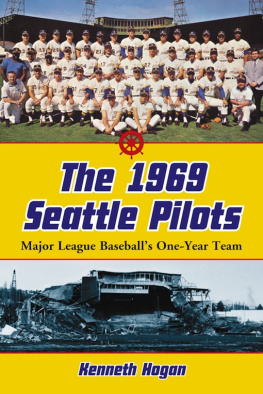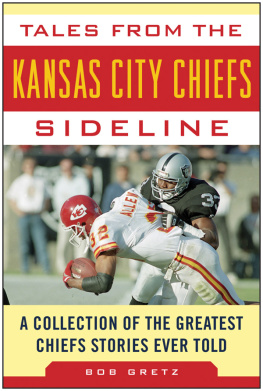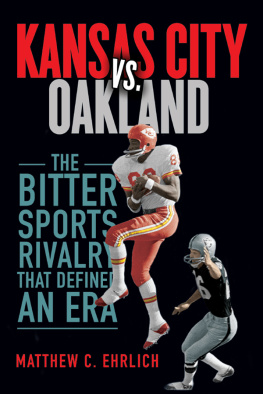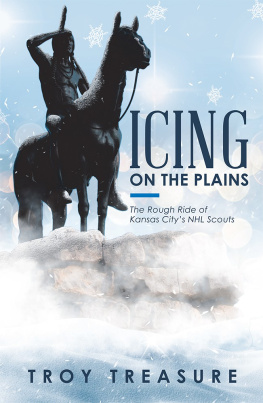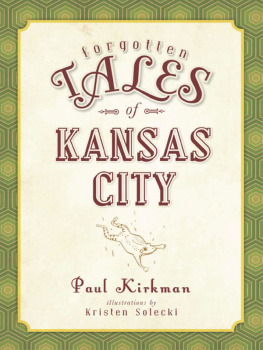
Table of Contents
[LIBRARY OF CONGRESS ONLINE CATALOG]
Peterson, John E., 1949
The Kansas City Athletics : a baseball history, 19541967 / John E. Peterson.
p. cm.
Includes bibliographical references and index.
ISBN-13: 978-0-7864-1610-3
1. Kansas City Athletics (Baseball team)History.
GV875.K3 P48 2003
796.357'64'09778'411dc22 2003016500
British Library cataloguing data are available
2003 John E. Peterson. All rights reserved
No part of this book may be reproduced or transmitted in any form or by any means, electronic or mechanical, including photocopying or recording, or by any information storage and retrieval system, without permission in writing from the publisher.
Front cover: 1964 team photograph.
(From the Kansas City Athletics.)
McFarland & Company, Inc., Publishers
Box 611, Jefferson, North Carolina 28640
www.mcfarlandpub.com
For
Stan Peterson, my father,
who took me to Kansas City to watch Athletics games;
Linda Peterson, my wife,
whose love and support helped me write this book;
and Dr. Milton Engebretson,
who encouraged me to write this book.
Preface
Why a book about the Kansas City Athletics?
The team did not have a long history. Arnold Johnson purchased the Philadelphia Athletics and moved them to Kansas City in 1954. They were in Kansas City just 13 seasons before Charlie Finley moved them to Oakland in 1968.
The As were the worst team in modern baseball history. The 1962 New York Mets lost 120 games in their inaugural season, but they won the World Series in 1969. The Kansas City Athletics were consistently bad. They won 829 games and lost 1,224, a winning percentage of just .404, and never came close to a winning record in any season. Only four teams can match or exceed 13 consecutive losing seasonsthe Boston Red Sox, the Seattle Mariners, the Philadelphia Phillies and the Philadelphia Athleticsbut at least these teams had winning seasons and championships to counterbalance their losing seasons. The Tampa Bay Devil Rays are the only other team in modern baseball history never to have a winning season. The Milwaukee Brewers of 1901 and the Seattle Pilots of 1969 had losing records in their only season of existence before relocating.
Despite this futility the As had a fascinating and colorful history. Few teams had as many interesting events occur in such a brief period of time. Yet nobody recorded these events in a book. Books written about Oakland Athletics contain little information about the Kansas City years; other books mention the Kansas City Athletics in passing. I felt compelled to write this book so that the rich heritage of the Kansas City Athletics would not be lost.
Besides, the Kansas City As were my team. I grew up in Omaha, listened to the games on the radio, and heard Monte Moores glowing descriptions of the great plays made by the As players. I wondered why such an outstanding collection of players did not win more games. I believed him when he said the team played well (despite the loss), when he predicted some minor league player in Birmingham would soon become an All-Star player in Kansas City, and when he explained why a player obtained in a trade would improve the team. Kansas City As fans had to be optimistic.
It was always exciting to go to Kansas City to see the As in person. Sometimes my father drove to Kansas City and parked our car in one of Sams lots (or in somebodys back yard). Sometimes we rode a train that the Burlington railroad occasionally ran between Omaha and Kansas City especially for As games. I felt something special every time I walked into the stadium.
Some of my friends were As fans. We started an unofficial As fan club called COFFINCharles O. Finley Fans in Nebraska. Other friends were Yankees fans. They often reminded me that their team was better than my team. One these Yankees fans made a cartoon of As catcher Doc Edwards with the caption: He is the classic example of a bad catcherhe cant catch, throw or hit. I wished I had kept the cartoon when the As traded Edwards to the Yankees a few weeks later!
The As may have been bad, but they were my team, win or loseor lose and lose.
1
Big League Dreams
Bill Veeck wanted to move the St. Louis Browns to Baltimore. The American League met in July 1953 to discuss the Browns future, and Yankees owner Del Webb wanted the team to move to Kansas City. The Yankees owners motives were hardly altruistic, wrote James Miller. Kansas City was a New York AAA farm club. A move to that city would mean financial compensation for his club and the shift of its AAA farm club to a lucrative market in Denver. Moreover, Kansas Citys municipal government was preparing to purchase the local stadium from the Yankees and finance a major expansion of its seating. Webbs construction company was bidding for the job. The city would enlarge the seating capacity of the stadium from 17,500 seats to 35,000.
Kansas City Star sports editor Ernest Mehl, John McDermott from the Junior Chamber of Commerce, Alex Levi, president of Macys Department Store in Kansas City, councilman Joe Nolan, Chamber of Commerce president Karol Koerper and Lester Milgram, owner of Milgram grocery stores, led the citys efforts to obtain a major league team. Mayor William E. Kemp, Milgram, McDermott and city councilman Robert Benson went to the American League meeting in New York before the start of the 1953 World Series. The owners listened to representatives from Kansas City, Los Angeles, Baltimore and other cities before approving the sale to a Baltimore group. The Kansas City delegation realized they needed a person or group with adequate capital to buy and operate a team. They also needed a larger stadium. Previously, all the major league teams except Cleveland built their own stadiums; now, major league teams expected cities to provide stadiums.
Kansas City had another opportunity one year later. The Philadelphia Athletics, owned by legendary Connie Mack, were one of the best teams in baseball until the Great Depression. Since that time they had struggled on the field and at the box office. The team was plagued by family problems that could be traced back to 1901. Benjamin Shibe owned 50 percent of the team (750 shares) and Mack owned 25 percent (375 shares) in the teams first season in the American League. The other 25 percent of the shares went to Sam Jones and Frank Hough, two local newspapermen, who each owned an eighth interest.
Mack was offered the managerial reins of the New York Yankees following the 1912 season. As a counter-offer, Shibe loaned Mack $113,000 to buy the shares owned by Jones and Hough. Mack bought the shares on November 16, 1912. Shibe passed away in 1922 and his family of two sons (Tom and John) and two daughters inherited As stock, as did two grandsons, Frank and Benny Macfarland. Tom Shibe died on February 16, 1936, and John Shibe died just one year later on July 11, 1937. The John Shibe estate was insolvent and by 1940 Connie Mack purchased 141 shares of stock from the estate. Mack held the majority ownership of the team by a margin of 891 shares to 609 shares still held by members of the Shibe family.
Mack, who married Margaret Hogan in 1887, had three children: Roy, Earle and daughter Marguerite. Mrs. Mack passed away five years after they were married and Mack married Katherine Hallahan in 1910. They raised five childrenfour daughters and one son, Connie Mack Jr. Mack wanted all three of his sons to join the organization. Earle served a 14-year apprenticeship as a minor league player and manager, coached the As in 1924 and was appointed assistant manager in 1939. Roy started working in minor league offices in 1915 and became the As vice president in 1935. Connie Jr. joined the organization in 1935. He wanted to make changes, but his brothers felt his ideas were impractical. The franchise was threatened by intermittent warfare between Earle and Roy on one side and Connie Jr. and his mother on the other. Connie Sr. had grown somewhat indecisive and was swayed first by one side and then the other.
Next page
